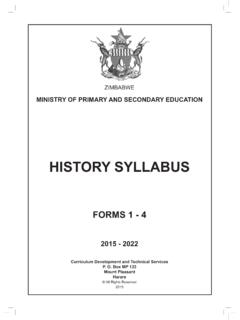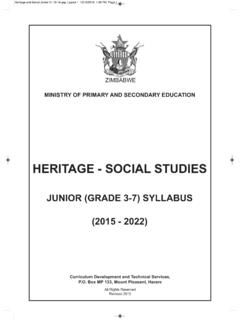Transcription of MATHEMATICS SYLLABUS FORMS 1 - 4 - Free ZIMSEC & …
1 MINISTRY OF PRIMARY AND SECONDARY EDUCATIONZIMBABWEMATHEMATICS SYLLABUS FORMS 1 - 42015 - 2022 Curriculum Development and Technical ServicesP. O. Box MP 133 Mount PleasantHarare All Rights Reserved2015 MATHEMATICS SYLLABUS FORMS 1 - 4 ACKNOWLEDGEMENTThe Ministry of Primary and Secondary Education wishes to acknowledge the following for their valued con-tribution in the production of this SYLLABUS : National panellists for Form 1 to 4 MATHEMATICS Representatives from Higher and Tertiary Institutions Representatives from the following organisations:- zimbabwe school Examinations council ( ZIMSEC )- United Nations International Children s Emergency Fund (UNICEF)- United Nations Educational, Scientific and Cultural Organisation (UNESCO)iMathematics SYLLABUS FORMS 1 - PRESENTATION OF SYLLABUS METHODOLOGY AND TIME SCOPE AND 3 FORM ONE (1).. FORM (2).. FORM THREE (3).. FORM FOUR (4).. 70 ASSESSMENT 72 MATHEMATICS SYLLABUS FORMS 1 - IntroductionIn developing the MATHEMATICS SYLLABUS attention was paid to the need to provide continuity of mathematical concepts from primary school level to form 4 and lay foundations for further studies and career development.
2 It is intended to produce a citizen who is a critical think-er and problem solver in everyday life. The four year learning area will provide learners with opportunities to apply mathematical concepts to other learning areas and enhance mathematical literacy and numeracy. It also de-sires to produce a learner with the ability to communicate effectively, with proper qualities of team work. In learning MATHEMATICS , learners should understand and master a variety of skills, knowledge, concepts and processes in order to investigate and interpret numerical and spatial relationships and patterns that exist in the world. It also caters for learners with diverse needs to experience MATHEMATICS as relevant and RationaleZimbabwe is undergoing a socio-economic transforma-tion where MATHEMATICS is key to development, therefore, it is imperative that learners acquire necessary mathe-matical knowledge, skills and develop a positive attitude towards the learning area.
3 This will enable learners to be creative thinkers, problem solvers and communicators with values of unhu/vumunhu/Ubuntu such as discipline, integrity and honesty . The knowledge of MATHEMATICS enables learners to develop mathematical skills such as accuracy, research, logical and analytical competencies essential for sustainable development and in life. The im-portance of MATHEMATICS can be underpinned in inclusiv-ity and human dignity and is a universal language that cuts across all boundaries and unifies diverse cultures. MATHEMATICS plays a pivotal role in careers such as en-treprise, education, medicine, agriculture, meteorology, engineering and others. Summary of ContentThe SYLLABUS covers the theoretical and practical broad mathematical concepts. The SYLLABUS covers operations with real numbers, manipulation of algebraic symbols and techniques, formulating and solving equations, draw-ing and interpreting graphs and making inferences from statistical data and representation.
4 AssumptionsIn developing the SYLLABUS it is assumed that the learner has : completed primary education basic knowledge of primary MATHEMATICS SYLLABUS concepts such as: - number- operations- measures- relationships ability to use ICT Cross Cutting themesThe following are some of the cross cutting themes in MATHEMATICS : Business and financial literacy Disaster and risk management Communication and team building Environmental issues Gender Enterprise skills HIV & AIDS ICT Unhu/ PRESENTATION OF SYLLABUSThe MATHEMATICS SYLLABUS is a single document covering FORMS 1 to 4 . It contains the preamble, aims, assess-ment objectives, SYLLABUS topics, scope and sequence and competency matrix. The SYLLABUS also suggests a list of resources to be used in the learning and teaching AIMSThe SYLLABUS will enable learners to: develop an understanding of mathematical concepts and processes in a way that encourages confidence, enjoyment and interest further acquire appropriate mathematical skills and knowledge develop the ability to think clearly, work carefully and communicate mathematical ideas successfully apply MATHEMATICS in other learning areas and in lifeMathematics SYLLABUS FORMS 1 - 42 develop an appreciation of the role of MATHEMATICS in personal, community and national development engage, persevere, collaborate and show intellec-tual honesty in performing tasks in MATHEMATICS , in the spirit of Unhu/ Ubuntu/Vumunhu use tools to solve mathematical SYLLABUS OBJECTIVESThe learners should be able to.
5 Use mathematical symbols, terms and definitions in problem solving construct appropriate mathematical models that can be applied in solving problems in life draw inferences through manipulation of mathe-matical data communicate mathematical ideas and information clearly and effectively in various contexts solve a wide range of problems involving algebraic and geometric concepts apply mathematical concepts in other learning areas use tools in problem solving conduct research projects including those related to enterprise METHODOLOGY AND TIME ALLOCATIONIt is recommended that teachers use teaching tech-niques in which MATHEMATICS is seen as a process which arouse an interest and confidence in solving problems in both familiar and unfamiliar contexts. The teaching and learning of MATHEMATICS must be learner centred. Multi-sensory principles should also be applied during teaching and learning of MATHEMATICS . The following are some of the suggested methods of the teaching and learning of MATHEMATICS Guided discovery Discussion Interactive e-learning Exposition Demonstration and illustration Problem solving Individualisation Simulation Visual tactile Educational tours Expert guest Time AllocationSix periods of 40 minutes each per week should be allo-cated for the adequate coverage of the SYLLABUS .
6 TOPICSThe following topics will be covered from Form 1 to Real Financial Measures and ProbabilityMathematics SYLLABUS FORMS 1 - SCOPE AND SEQUENCE7. 1 REAL NUMBERS MATHEMATICS SYLLABUS Form 1 4 2015 6 SCOPE AND SEQUENCE Real numbers SUB TOPIC FORM 1 FORM 2 FORM 3 FORM 4 Number Concepts and Operations Number types Factors and multiples Directed numbers Fractions and percentages Order of operations Factors and multiples Squares and square roots Cubes and cube roots Order of operations Irrational numbers Number patterns Approximations and estimations Round off numbers Decimal places Significant figures Estimations Significant figures Estimations Limits of accuracy Ratios, rates and proportions Ratios Ratios Proportions Ratios Rates Proportions ordinary and standard form Large and small numbers Numbers in standard form Operations in standard form Number bases Number bases in everyday life Place values Converting numbers from one base to another (Bases 2, 5 and 10)
7 Operations in number bases from base 2 to base 10 Scales and simple map problems Scale measurement Scale drawing Scale factor Area factor MATHEMATICS SYLLABUS FORMS 1 - 447. 2 Sets MATHEMATICS SYLLABUS Form 1 4 2015 7 Sets SUB TOPIC FORM 1 FORM 2 FORM 3 FORM 4 Sets Sets and Set notation Types of sets Types of sets Venn diagram with two subsets Set Builder Notation Venn diagrams with three subsets Financial MATHEMATICS MATHEMATICS SYLLABUS Form 1 4 2015 8 Financial MATHEMATICS TOPIC FORM 1 FORM 2 FORM 3 FORM 4 Consumer arithmetic Household bills Profit and loss Discount Household budgets Corporate bills Profit and loss Simple interest Hire purchase Small scale enterprise budgets Bank statements Compound interest Commission Hire purchase Foreign exchange Sales and income tax rates (Pay as you earn (PAYE)) Value added tax (VAT) Customs and Excise Duty Measures and Mensuration MATHEMATICS SYLLABUS Form 1 4 2015 9 Measures and Mensuration SUB TOPIC FORM 1 FORM 2 FORM 3 FORM 4 Measures Units of : - Time - Mass - Length - Temperature - Capacity Units of.
8 - Area - Volume - Capacity - Density Mensuration Perimeter of plane shapes Area of plane shapes Perimeter of plane shapes Area of plane shapes Volume of cuboids Density of cuboids Perimeter of combined shapes Area of combined shapes Volume of cylinders Area and volumes of solid shapes Surface area Density MATHEMATICS SYLLABUS FORMS 1 - Graphs MATHEMATICS SYLLABUS Form 1 4 2015 10 Graphs SUB TOPIC FORM 1 FORM 2 FORM 3 FORM 4 Functional Graphs Cartesian plane Scale Co-ordinates Cartesian plane Table of values Linear graphs Scale Functional Notation Linear graphs Quadratic graphs Cubic graphs Inverse graphs Travel Graphs Distance time graphs Distance time graphs Distance time graphs Speed-time graphs Displacement time graphs Velocity-time graphs Variation MATHEMATICS SYLLABUS Form 1 4 2015 11 Variation SUB TOPIC FORM 1 FORM 2 FORM 3 FORM 4 Variation Direct variation Direct variation Inverse variation Joint variation Partial variation MATHEMATICS SYLLABUS FORMS 1 - Algebra MATHEMATICS SYLLABUS Form 1 4 2015 12 Algebra SUB TOPIC FORM 1 FORM 2 FORM 3 FORM 4 Algebraic Manipulation Basic arithmetic processes in letter symbols Substitution of values Algebraic expressions Substitution of values Algebraic expressions Algebraic fractions Quadratic expressions Factorisation Algebraic fractions Highest Common Factor (HCF) and Lowest Common Multiple (LCM)
9 Of algebraic expressions Quadratic expressions Factorisation Algebraic fractions Quadratic expressions Factorisation Completing the square Equations Linear equations Equations with brackets Equations with fractions Change of subject of formulae Simultaneous linear equations Quadratic equations Simultaneous equations Quadratic equations Change of subject of formulae Substitution of values Completing the square Quadratic formulae Inequalities Inequality signs Linear inequalities Number line Linear inequalities Number line Cartesian plane Simultaneous inequalities Graphs of inequalities Linear programming Indices and Logarithms Index form Laws of indices Indices Logarithms Theory of logarithms Equations involving indices and logarithms MATHEMATICS SYLLABUS FORMS 1 - 477. 8 Geometry MATHEMATICS SYLLABUS Form 1 4 2015 13 7. 8 Geometry SUB TOPIC FORM 1 FORM 2 FORM 3 FORM 4 Points, lines and angles Points Lines Angles Angles Parallel and Transversal lines Angles of elevation and depression Bearing Cardinal points Three figure bearing Compass bearing Three figure bearing Compass bearing Polygons and circles Polygons Circles Properties of polygons (triangles and quadrilaterals)
10 Properties of polygons Angles of polygons Numbers of sides of polygons Circle theorems Similarity and Congruency Similar and congruent figures Cases of congruency Scale factor Areas of similar figures Volume and mass of similar solids Constructions and Loci Construction of lines and angles Construction of angles Bisecting lines and angles Construction of triangles and quadrilaterals Construction of diagrams to a given scale Loci Symmetry Line symmetry in two dimensions Rotational symmetry in two dimensions MATHEMATICS SYLLABUS FORMS 1 - StatisticsSUB TOPICFORM 1 FORM 2 FORM 3 FORM 4 Data collection, classification and representation Data collection Data classification Data collection Classification of ungrouped data Representing data using frequency tables, bar charets and pie charts Collection and classification of grouped data Frequency table Pie chart Histogram Frequency polygon Bar chart Frequency table Frequency polygon Cumulative frequency table Cumulative frequency curveMeasures of central tendency Mean Class mode Median Assumed mean Mean, median and modal class of grouped data Assumed mean Median from cumulative frequency curveMeasures of Dispersion Quartiles Inter quartile range Semi- inter quartile rangeMathematics SYLLABUS FORMS 1 - Trigonometry MATHEMATICS SYLLABUS Form 1 4 2015 15 Trigonometry SUB TOPIC FORM 1 FORM 2 FORM 3 FORM 4 Pythagoras theorem Pythagoras theorem Pythagorian trippleS Trigonometrical ratios Trigonometrical ratios of acute angles: - sine - cosine - tangent Trigonometrical ratios of obtuse angles.








